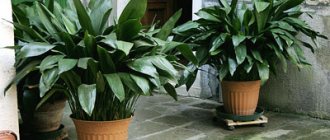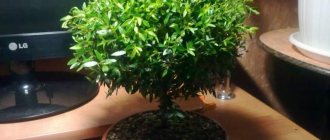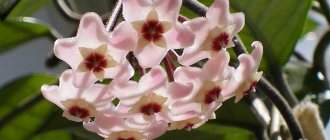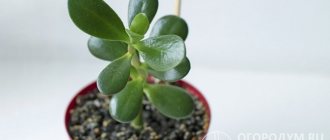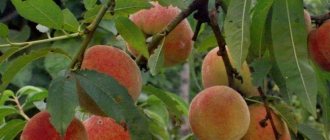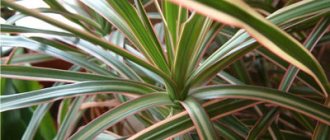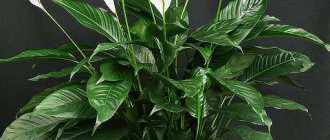This plant is known as domesticated. Discovered in the 18th century by the German botanist Jacob Christoph Scheffler. Taiwan, Australia, Asia, New Zealand, and the islands of Oceania are considered to be the birthplace of these evergreen specimens. About 600 species are known. Trees, shrubs and vines are represented. Schefflera flower is easy to care for at home, however, knowledge of some nuances will not be superfluous.
Dwarf and tree-like ones up to 1.5 meters in height are grown indoors. They are used to make compositions, form a lush crown, and place them in florariums.
It is important to know! Leaves, stems and roots are poisonous and contain alkaloids and nitrogen-containing substances.
Recommendation: avoid contact with children and pets. Keep such vegetation in a separate room, a winter garden. After contact, wash your hands thoroughly to prevent dermatitis. Pollen can also cause allergies or other unpleasant symptoms.
Individuality and popular types
Schefflera is loved for its unusual foliage and is called a “tropical umbrella.” The leaves, also called lobes, on the branch grow from one petiole and look like a palm with outstretched fingers or an umbrella. The lobules and pattern give the name to some varieties, eight-leafed, finger-shaped. Also called umbrella.
The leaf is divided into 4-16 halves. It is painted dark green, variegated, interspersed with white-beige and yellow shades. In nature, scheffleras bloom in a unique way. Inflorescences are paniculate or racemose. Indoor flowering is rare, and when it blooms, it produces panicles with white-beige flowers.
Known and developed Scheffler varieties are conventionally divided into two types:
- Potted.
- Ground or wild growing.
Description
Schefflera (or Schefflera) is native to many countries with tropical climates. In nature, it grows in the form of a tree or shrub. There are species that reach a height of forty meters. These species are not suitable for indoor breeding. Many specimens in nature have more modest sizes, reaching two meters. In indoor conditions, the plant can reach one and a half meters. Therefore, the plant can be more often found in spacious halls, offices, and winter gardens. If space allows, then Schefflera can be successfully grown in an apartment, you just need to take into account its rapid growth.
It belongs to the Araliaceae family, and about 400 species grow in nature. The plant got its name from the name of the famous botanist Jacob Christian Scheffler from Germany. It is characterized by umbrella-shaped leaves, consisting of several dissected lobes. The number of lobes on a leaf ranges from 4 to 12, depending on the variety. The leaves are located on long petioles.
In nature, the plant blooms with inconspicuous small white flowers collected in an umbrella. It is not possible to achieve schefflera flowering indoors, but this does not upset flower growers. Because decorative leaves more than compensate for the lack of flowers.
Radifolia
Stellate or star-leaved. The color is dark green, interspersed with shades. Wax leaf, 16 pieces in one umbrella. The length exceeds 20 centimeters. Found in Australia, on the islands of New Guinea, Java. Natural specimens grow over 9 meters.
It blooms with huge racemose, starfish-like inflorescences. In cozy rooms it can reach a height of two meters, but grows slowly. There are 6-7 leaf halves.
Woody
She is also “tree-like”. In Australia and New Guinea, this vine is loved and used to create compositions and green walls. It blooms only after 8 years of life. The number of slices is 7-16 pieces. Instances derived from it are called: Melanie, Nora, Janine, Beautiful, Golden Chapel, Diana, Green Chapel and many others.
Coloring varies. From wood shefflers they create standard fences and compositions by planting several shoots together. The grown stems are connected, cared for, and intertwined with each other all the time. Exotics bred by breeders are liked by flower growers.
Important! Before purchasing, transplanting, pruning and propagating flowers, read various sources.
Trimming
Often, to make shefflera look as lush as in the photographs, several plants are planted in one pot at once. In addition, the flexible trunks of young plants can be woven into shapes, as long as this can be done without breaking. And in order for the shefflera bush to form a neat crown, it is pruned. True, the plant must be pruned correctly, otherwise it will suffer.
Schefflers also perform low pruning in case of almost complete fall of leaves due to improper care. True, saving a plant by pruning is possible only if the root system is healthy. The remaining stumps should be watered regularly, soon the plant will rejuvenate and new shoots will appear on it.
Light and watering
Regular watering is necessary; drying out is unacceptable. Excess humidity will also not do any good. During development from March to November, it really needs water. Touch the soil layer with your hands, water it if it’s dry, put it aside for a day if it’s over-moistened. Wipe the sheets regularly with a damp cloth or cotton pads.
To add shine, there are special formulations on sale. Spray with water often (3-5 times a week in summer, not necessary in winter). Remember that soft, settled water at room temperature is the best means for watering.
Temperature and feeding
Schefflers are dormant in cold weather, from December to February. Irrigation is weak and fertilizers are excluded. A lower temperature regime is welcome, but not lower than +12°C. Optimal environment +15.16°C. They rest and gain strength.
Keep flowerpots away from heaters and radiators. Can be placed on the floor, close to the light. Avoid any drafts. Don’t forget to humidify the air and occasionally spray it with water.
Favorable summer temperatures are from +20 to +25°C. Keep in mind that plants are drawn to light. Use this to create a stunning crown. Rotate the container a couple of times a week. You can try taking it outside or onto the balcony. If the temperature changes are not too sharp, there is no rain, but it is humid and light, the Schefflera will like it.
After winter rest, rapid growth begins. Add mineral and organic fertilizers to the water for irrigation 3-4 times a month, then a little less often, 2-3 times. As mentioned above, do not dry out, but do not flood the soil.
Agree, this flower does not require complex care even in winter.
Landing
The ideal soil for planting Schefflera is considered to be a purchased mixture, for example, for roses, palm trees, ficus trees, or simply for decorative foliage flowers.
The most important component of the soil is that it must allow air to pass well to the depth. For this reason, experienced gardeners prefer to add perlite to the soil in sufficient quantities (approximately 50:50 with soil). Also, it is better to give preference to mixtures rich in minerals, since Schefflera develops very quickly.
Transplantation and soil
The young growing miracle must be replanted once a year in spring or late autumn. If the soil is not too entwined with roots, then take a pot 5-6 cm larger in diameter.
Sometimes an illness or improper care slows down growth, then you can do without transplants or take a container for replanting that is only 3-5 cm longer in diameter. An adult tree that has reached its growth limit does not require renewal. Add top layer or change as needed.
The same soil filling is used for replanting and propagation. Store bought is suitable for palm trees (dracaena). Add a little humus and processed river sand (in a ratio of 2:1:1, respectively).
If you collect sand yourself, fry it in the oven. Leave to air, which promotes the development of beneficial microflora. The soil composition should be light and non-alkaline.
Place drainage at the bottom of the pot. Take expanded clay or make your own from small gravel, ceramic or brick shards, or put in pieces of foam. Now everything is ready for transplanting and diving.
Useful tips for caring for Schefflera
- When buying a plant, pay attention to the leaves. They should be bright, green and look like well-polished leather. When purchasing radiata, pay attention to the shape of the plant.
- If your Schefflera has lost its leaves, then in the spring put it in the open air and water it generously. Over time, the leaves will grow back and the plant will regain its original exotic appearance.
Purpose. An ideal planter and potted plant for winter gardens, lobbies, staircases and cool living spaces. Grows well in hydroponics.
PS My elderly parents live in a rural area and I really want to make their life comfortable and comfortable. Not long ago I learned about TOPAS (a treatment plant), which performs the simplest actions and at the same time purifies wastewater by 98%. I will make a gift for my family and loved ones for their golden wedding anniversary.
Crown formation
If the schefflera is not pruned, it will grow straight up. A straight, upright tree with lush foliage, beautiful but not elegant. Forming a flower will take time, it will force you to show your skills and demonstrate your taste. Come up with a design for a leafy cap, a variation of a trunk or a bonsai in advance and follow it.
Treat sections with immunomodulators or other agents. Don't forget that lighting also plays a big role in adding volume. Remember, variegated pets absorb much more light!
After pruning, pay close attention to all changes; the trees are still weak, capricious, and susceptible to pests.
Reproduction
Scheffleridae reproduce well in several ways:
- cuttings;
- air layering;
- seeds.
Cuttings
Cuttings can be taken during the process of trimming the crown or specifically for propagation and cultivation. For this purpose, cut off the top or side layer with a sharp knife. Deepen the cuttings 2-4 centimeters into prepared, moist soil.
Cover the top with cellophane (remove and ventilate a couple of times a day) or with a cloth, for example, agrill (you don’t have to ventilate). Impregnate the stem or side surface in the cut areas with Epin or sprinkle with crushed activated carbon.
Air layering
A very convenient method of propagation is air layering. Look for suitable stems and cut them diagonally with a sharp knife. Apply a stimulant. Wrap polyethylene or a piece of agril around the trunk, just below the notched area, and tie it. Raise the edges of the material so that a bowl is formed, fill it with turf mixed with a small amount of sand and humus.
Moisten the contents, tie the edges of the bag to the trunk above the notch. Roots should appear within 1-2 months. Once the goal is achieved, remove the bag of turf and cut the finished cutting.
Seeds
You can purchase seeds and try to see the whole process, how Schefflera grows from a small seed into a spectacular plant. Place drainage and moist soil in the box (according to the above recipes). Make 1.5-2 cm indentations, place the treated seeds (if the manufacturer has not treated them, soak them in an immunostimulant) and sprinkle.
Unfortunately, brightly colored varieties do not tend to propagate easily.
Cover the top with agrill or a plastic bag (ventilate once a day). Avoid drying out and over-moistening. After producing 2 or 3 leaves, the seedlings can be planted in small pots.
Growing conditions
More than 590 species of Schefflera are found in the wild. At the same time, the plant is large in size, and many species can grow in natural conditions up to 40 meters in height.
Such gigantic varieties, of course, are not used in indoor floriculture. For the most part, in home cultivation, preference is given to a maximum of 1.5-2 meter Schefflers.
Interesting! Very often Schefflera can be found in large flowerpots installed on the floor. The plant, when mature, is striking and adds aesthetics to any room, but most of all to office and public places.
Scheffleras come with variegated leaves, boat leaves, or leaves with an interesting, wavy edge. Therefore, the variety of forms of the future plant is amazing and, perhaps, can easily satisfy any request.
The key feature of the Schefflera bush is lush greenery, practically without flaws . The leaves are formed in rosettes and racemes, tightly covering the trunk and branches.
Schefflera's flowers are very small. In nature, they are collected in brushes like bunches of grapes and often stand out faintly against the background of fairly large leaves. In captivity, it is almost impossible to achieve flowering, much less fruiting, of Schefflera.
Temperature
But even without flowering, Schefflera looks attractive. In many ways, it’s all about the large, often interestingly shaped leaves.
And in order for the plant to always look neat and healthy, you need to comply with some requirements for environmental conditions. The most important thing is the temperature background. It may seem that Schefflera loves high temperatures due to its tropical growth, but this is far from the case. Under natural conditions, the flower grows in shady tropical forests, so it just likes coolness.
- In summer, the optimal temperature is +20-22 C.
- In winter, the plant feels good from +14 C to +18 C.
And note that Schefflera is more likely to easily tolerate a slight drop in temperature than a sharp jump upward. In extreme heat, it is not uncommon for a flower to shed most of its foliage, after which it takes a long and difficult time to recover.
Air humidity
Another important point that you will have to monitor is air humidity. In the case of the Schefflera flower, you will have to keep a container of water nearby almost all year round. Naturally evaporating, the water will increase the air humidity to the required limits.
You can also give preference to modern humidifiers that measure humidity and effectively increase it to preset values. But this option will require financial investment and is not suitable for everyone.
Lighting
All varieties prefer to be grown without direct contact with the sun. But at the same time, they are extremely jealous of the level of lighting. For example, with active growth, Schefflera may even require artificial supplementary lighting during the cold season.
The optimal daylight hours for Schefflera are 10-12 hours. Based on this, the flower feels best close to the windows, but with obligatory shading from direct sunlight with screens or other flowers.
Choosing a place to put a flower pot
In general, plants, being already in an adult state, feel great even in the corners of rooms, away from windows.
But it is better to grow a young flower in good light for the first time. For this reason, it is better to place the pot on windows facing west or east, where there is sufficient daylight, but ultraviolet radiation is less intense. On the other hand, if the sun is too aggressive and hits the foliage, it would not be a bad idea to shade Scheffler.
Certain varieties can be grown on north-facing windows. But this only applies to those species whose foliage is standard green. The variegated varieties on the north side will lose their identity and will be colored in the usual green shade.
But southern windows for Schefflera are suitable only in the cold season. In summer the sun there is too aggressive and hot.
What does it look like in the interior?
Schefflera looks harmonious in almost any room design. Its main feature - lush and large foliage - will invariably complement and decorate the room.
You can definitely fit a Schefflera flower into a classic interior, as well as any other extraordinary decoration.
It is known that the plant looks good even in modern types of design, although in them there is a noticeable commitment to general minimalism and high functionality.
How to prevent the disease and cure it
Important! If you take proper care, following all the recommendations, this will be the prevention of diseases.
If you bring new vegetation into your home that looks amazing, place it separately anyway. Watch. Give a small shower and wipe the leaves with a soap and water solution for prevention (if all this is possible for a given sample or at a given time). Only after quarantine place the new product next to other flowers.
In case of illness, the following measures are effective:
- cover the container with plastic and arrange a shower;
- thoroughly rinse the tree with the solution;
- if the shower and solution do not help, use insecticides, taking precautions;
- change the soil filler, drainage and pot.
What to treat with: ethyl alcohol solutions, soap; infusions of tobacco, garlic or onion peels. When gentle infusions and solutions do not help, chemicals are used: actellik, confidor, actara, fitoverm or others. A sick pet is isolated until completely cured.
Schefflera - signs
When a shefler is accused of energy vampirism, one must admit that there is some truth in these accusations. Sheflera does absorb energy, but only negative energy, so don’t panic, but, on the contrary, try to spend some time next to her, especially if you are overcome by anxious or sad thoughts. Sheflera removes negativity and brings a feeling of harmony, helps to stop quarrels in the family. The best place in the house for sheflera is the bedroom. It is there that you relax during sleep, and the shefflera absorbs all your anxieties and neuroses, instilling vigor and peace.
Sheflera can be placed in the office or next to a schoolchild’s study corner, since esotericism suggests the plant’s ability to promote the productive acquisition of knowledge.
They also claim that with the help of sheflera you can predict the future. For example, those phenomena that we just explained by objective reasons are interpreted differently in the world of superstitions.
For example:
- if the leaves of the sheflera darken, this is a sign that there is a lot of negative energy in the room;
- if the cheflera falls off, this is a harbinger that someone living in the house will get sick, or a financial collapse will occur, the loss of a large amount of money;
- when the leaves of a plant curl up, this means a scandal with household members or work colleagues - it depends on where the plant is located;
- if the cheflera stopped its development for no apparent reason, this is an omen of future failures;
- unexpected intensive growth of the shefflera - a new addition to the family.
There is an opinion that a chef growing in the office attracts clients and good business partners, and, therefore, one can expect an increase in income. By the way, the plant helps most of all people born under the fire signs of the zodiac - Aries, Leo and Sagittarius.
How diseases manifest themselves
The foliage is strewn with dark and white dots, cobwebs, and dark scales. The surrounding surface may become covered with droplets of sticky moisture.
Typical pests:
- aphid;
- thrips;
- spider mite;
- scale insect
The above methods will help you deal with them.
In case of excess moisture, rot appears. Drain, if soil is damaged, replace.
Pests
Schefflera is attacked by pests of indoor plants such as spider mites, thrips and scale insects. Spider mites are noticeable by a white coating on the leaves and internodes, similar to small cobwebs. The scale leaves a sticky coating, and the insects themselves can be seen in the form of small brown tubercles on the leaves. Thrips can be detected by black dots on the back of the leaf blade.
Spider mite Thrips
Shchitovka
If the number of pests is small, you can use traditional methods:
- wash the leaves with soapy water;
- soak a cotton swab in alcohol and wipe the leaves where insects are found.
If these methods do not lead to the destruction of pests, then it is necessary to treat the plants with insecticides such as Aktara. After a week and a half, the treatment should be repeated.
Why does it drop leaves?
The leaves have been shed, which means there is an excess or lack of water, sun, and fertilizer. The situation can be corrected; make changes to the watering, lighting or feeding regime. Sometimes the leaves may first fade or turn yellow. This means there is not enough light.
Overwatering causes the edges of the leaves to darken. Take preventive measures to combat diseases. The toxicity is compensated by the presence of the ability to purify the air, saturating it with oxygen.
These are almost all the best tips you need to know to make your home greenhouse a joy, not a disappointment. Schefflera is a flower that is not difficult to care for at home, but requires attention and a caring attitude.
Lighting
Schefflera is moderately demanding of good lighting and will happily extend its palm-shaped leaves to the light. The ideal window is southern, acceptable are western and eastern.
Advice: if you want to have this plant, but the room is annoyingly dark, or the pot will be located not on the window, but in the back of the room, choose green rather than variegated types of schefflera. Variegated Schefflera have higher light requirements than regular green ones.
In the summer, the plant will be comfortable moving into fresh air. Watch out for scorching rays: they can burn the leaves, so take care of shading the bush during the active time of the sun.
